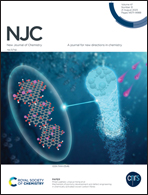Mechanism of porosity development and defect engineering in chemically activated woven carbon fibres†
Abstract
Carbon cloths (CCs) with their woven fibres are known to be inert with low specific surface area (SSA). To overcome these issues, activated CCs (ACCs) by potassium hydroxide (KOH) were chemically etched to create pores on the fibre surface homogeneously. Herein, various weight ratios (WRs) of the CCs to the etchant (KOH) were adopted to understand the pore development mechanism. The SSA of the ACC with a WR = 0.01 wt%/wt% was enhanced more than 15 times compared to that of the neat CC originating from outside-in pore deepening as the predominant mechanism for the pore growth as well as the intercalation of the metallic potassium during an etching redox reaction. Additionally, the defective sites across the fibre can be tuned by altering the bond angle and changing the orientation of basal planes through the KOH introduction, as proved by vibrational spectroscopy. The variation of activation conditions was correlated with the surface energy by comparing the role of constituted dispersive and specific energy components. Compared to the previously conducted research, the activated carbon fibres of this study with their outstanding features have provided insight into the pore development and defect engineering that can be applied for environmental or energy applications.



 Please wait while we load your content...
Please wait while we load your content...